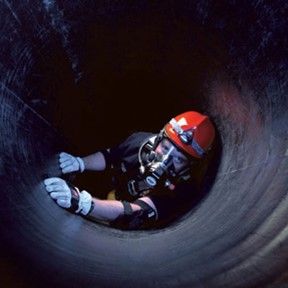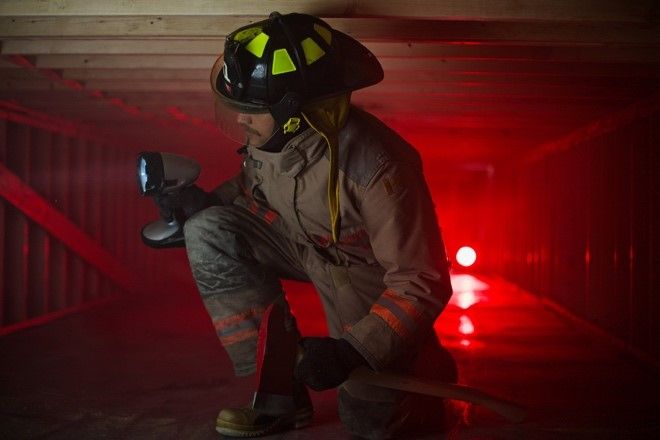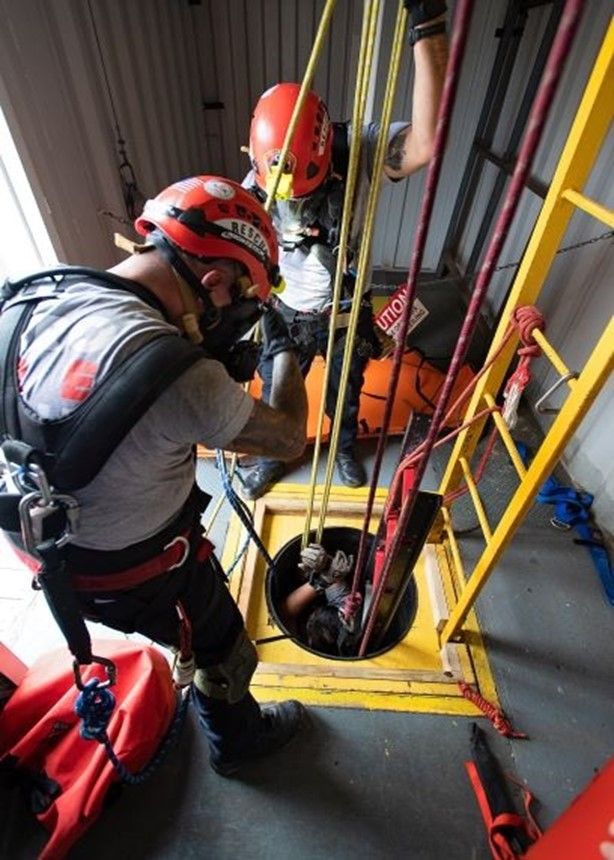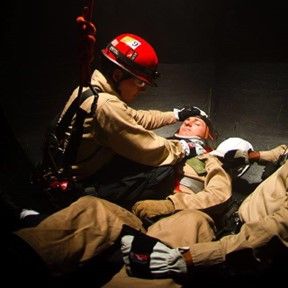Contributor: Roco Rescue

If entering permit-required confined spaces is performed at your worksite, then this is a question you absolutely should be asking yourself. And if you are, that is a good thing; it implies knowledge of OSHA’s requirement that an organization must provide for the safety of their personnel working in confined spaces.
Asking the question of “who” should provide your confined space rescue services means you are on the right track. You are aware of OSHA 1910.146 and have established that you are dealing with a permit-required confined space entry.
OSHA designates entries as permit-required when the space has one or more of the following characteristics:
1. Contains or has the potential to contain a hazardous atmosphere
2. Contains a material that has the potential for engulfing an entrant
3. Has an internal configuration such that an entrant could be trapped or asphyxiated by inwardly converging walls or by a floor that slopes downward and tapers to a smaller cross-section
4. Contains any other recognized serious safety or health hazardi

If a space at your facility where work is to be performed meets any of the above conditions, then OSHA clearly requires that you “develop and implement procedures for summoning rescue and emergency services, for rescuing entrants from permit spaces, for providing necessary emergency services to rescued employees, and for preventing unauthorized personnel from attempting a rescue.”ii
There are basically three options available to most organizations for the provision of a confined space rescue team: (1) local emergency services, (2) an in-house team, or (3) a contracted rescue service. Each of the three rescue options available are all viable choices; and all, when implemented appropriately, have merit. However, there are many factors to consider, and due diligence must be performed to determine the most effective choice.
Local Emergency Services
Upon learning that using local emergency services is potentially an allowable confined space rescue option, many organizations see this as the easy choice and quickly check that box. They are thrilled that they are not having to spend any money or devote any personnel to the task. These entities may also secretly wonder what all the hubbub is about regarding confined space rescue, but they very well may learn the hard way should an incident occur.
While there are local emergency services that have top-notch rescue capabilities, many (or perhaps most) are not that well equipped and/or trained to enter confined spaces for rescue purposes. If you are considering local emergency services to provide confined space rescue for permit-required entries, then there is homework that must be done before you check that box. This process should begin with a meeting with the local emergency services to assess the following:

- Are they trained and certified to perform confined space rescue?
- Are they properly equipped to provide this service?
- Are they available to respond/standby when entries are being made?
While some emergency services organizations may be well trained and adequately equipped to provide rope rescue in a high-angle environment, most do not have the right training and equipment for confined space rescue. Determining this level of detail requires serious due diligence to confirm, and as described later in this article, OSHA requires that you do this.
Aside from training and equipment, you must determine if the local emergency services are available to perform confined space rescue or standby services. This highlights the distinction between rescue available and rescue standby. “Rescue available” means the rescue team is available to be called out when some type of incident occurs. “Rescue standby” implies that the rescue team is standing by at the entrance to the space, ready to go at a moment’s notice.
Deciding which level of response is necessary is a function of the hazard(s) of the space. If the space is considered low hazard where the response is likely to be due to a medical issue with the entrant—e.g., heat stress, sprain, strain, etc.—then having a rescue team available to respond to the scene is permissible. However, if the space imparts a high degree of risk to the entrant(s)—an IDLH atmosphere, for example—then the rescue team should be on standby (literally standing by) outside of the space, ready to render immediate aid. Making this determination of rescue available vs. rescue standby applies to all situations, whether you are using local responders, in-house teams, or you contract out the service.
Although local emergency services are in the business of responding to emergencies (meaning they will come when you call), being on standby does not necessarily fit into those responsibilities—i.e., they may not be able to provide this service. And even if you are only requesting them as rescue available, they still may not be able (or willing) to obligate their trained members to always be available. Think about it: that is essentially asking their rescue-qualified members not to respond to other calls during the entry.
If using local emergency services is a route you want to seriously consider, then OSHA has a research assignment for you. (Note: this evaluation applies any time you are using an outside organization for rescue services.) You must evaluate:
1. Response Time – OSHA requires response in a “timely manner.” OSHA notes that “timely” depends on the hazard(s) present and refers to the Respiratory Protection Standard (1910.34) that requires standby persons when employees are wearing respiratory protection while working in an IDLH environment.
2. Training and Equipment – The prospective team must have the requisite training and equipment to proficiently perform rescue in the particular space(s) where entry will be madeiii
When selecting the local emergency services as your rescue team, it is imperative that the local emergency services know they have been selected for this role. If you have been performing your due diligence, this should be a foregone conclusion. But all too often, companies just check the box by their local responders and never let them know they have been designated for this role until an incident occurs. Should an accident happen where someone is injured, this is asking for a poor—if not disastrous—rescue outcome, as well as large fines from OSHA.
If you perform a really thorough assessment of the local emergency services, your findings will probably mimic those of many other organizations that have performed the same exercise—most local responder agencies are not trained, equipped, and/or available to provide standby or rescue services for confined space entries, period. The situation looks far bleaker for this option when you consider that they will be needed for every permit-required entry. It is a far bigger task than most local emergency response organizations want to deal with.
Also, while a written agreement with the local agency is not necessarily required by the regulation, it certainly would make it easier to document that an agreement to respond was in place – and that the department had an understanding of the scope of services to be provided at the employer’s site (i.e., confined space rescue). Roco has provided a sample for you to download.
In-house Teams
When contemplating the utilization of in-house teams, it is important to note the composition of most. It is the rare organization that staffs personnel whose sole job it is to provide confined space rescue and standby services. Most in-house teams consist of personnel who have other jobs, e.g., operators, engineers, maintenance persons, etc., who are trained to provide rescue and thus called out for standbys or actual emergencies.
There are numerous pros to using in-house personnel. They know the facility and the processes; they should have a good understanding of the hazard(s); it does not add to the payroll, and they are only needed when there is a risky entry or an actual rescue. Further, they are often additionally motivated because it is their colleagues whom they are serving. An in-house team makes good sense if the organization frequently conducts permit-required entries.
But an in-house team carries with it many attendant requirements, some of which can be challenging to manage. Training can be tricky. While OSHA does not specify the number of personnel that should be on a rescue team, the average is probably three to six members. This number can go up or down depending on the complexity (or lack thereof) of the scenario. Regardless, there must be enough people trained such that all shifts are covered, and allowances must be made for those staff persons being on vacation, out sick, etc. In addition to initial training, all team members must receive, at the minimum, annual rescue practice that covers the types of permit-required spaces they may encounter.iv

Along with adequate training and practice comes the equipping component. Confined space rescue is an equipment-intensive prospect. In addition to the PPE that OSHA mandates you provide employees, there is the myriad other gear that is required: ropes, harnesses, and hardware that is standard for all rope rescues, plus the confined-space-specific kit such as a tripod, SKED, air monitors, ventilation fans, and ducting. In addition to the acquisition of this equipment, it must be inspected on a regular basis with the inspection results documented and maintained.
When the training, staffing, and equipment responsibilities are taken together, significant behind-the-scenes activity is required to make an in-house system work efficiently.
Contracted Rescue Services
This brings us to the third option—contracted rescue services. If an organization infrequently performs permit-required entries, this option makes good sense. And it can be a far less expensive option than training, staffing, and equipping an in-house team.
There is a hybrid approach to making an exclusive decision between in-house or contracted rescue services. With a hybrid approach, the organization has an in-house team for their typical or routine entries but uses a contracted provider for long-duration projects or instances where there are multiple simultaneous entries being conducted that outstrip the resources of the in-house team.
The pros to using contract rescue services is that the organization avoids the significant effort and resource requirements of an in-house team. They are only needed during the entry, and when it is complete, they depart and the pay meter quits ticking. There is no training of personnel, no equipment to purchase, and no need to reorganize shifts and/or pay overtime to cover staffing. The possible con is that quality rescue services are not exactly cheap, so there will be an expense involved which can be significant if the services are required for an extended period. You will also have to perform due diligence about the prospective service’s capabilities, just as you would with the local emergency services. In Appendix F of 1910.146, OSHA provides non-mandatory guidance on the selection criteria for selecting a rescue service. Roco also has a Confined Space Compliance Guide that offers additional information.

It is important to note that by selecting a third party to perform rescue services, the confined space and the activities that occur in and around it remains your responsibility. This means that you cannot contract out your OSHA exposure/liability should an accident occur during a rescue attempt. At the end of the day, it is still your space. You still need to make sure that the process is being followed and that safety is being provided.
. . .
Regardless of which option you choose for confined space rescue services, it is important that you do it right. If you are contracting out the provision of rescue, you are obligated to thoroughly investigate the provider’s credentials and client references. You can be assured that when an accident happens, OSHA will perform a forensic review of your documentation and your policies, as well as those of your rescue service. If you have skipped a step or only addressed them in cursory fashion, OSHA will discover it and potentially issue citations and fines. But one should never lose sight of the fact that the real loser in this scenario is the employee who receives poor or delayed care during the emergency.
References
[i] OSHA 1910.146(b), 1910.146 – Permit-required confined spaces | Occupational Safety and Health Administration (osha.gov)
[ii] OSHA 1910.146(d)(9), 1910.146 – Permit-required confined spaces | Occupational Safety and Health Administration (osha.gov)
[iii] 1910.146(k), 1910.146 – Permit-required confined spaces | Occupational Safety and Health Administration (osha.gov)
[iv] OSHA 1910.146(k)(2)(iv), 1910.146 – Permit-required confined spaces | Occupational Safety and Health Administration (osha.gov)